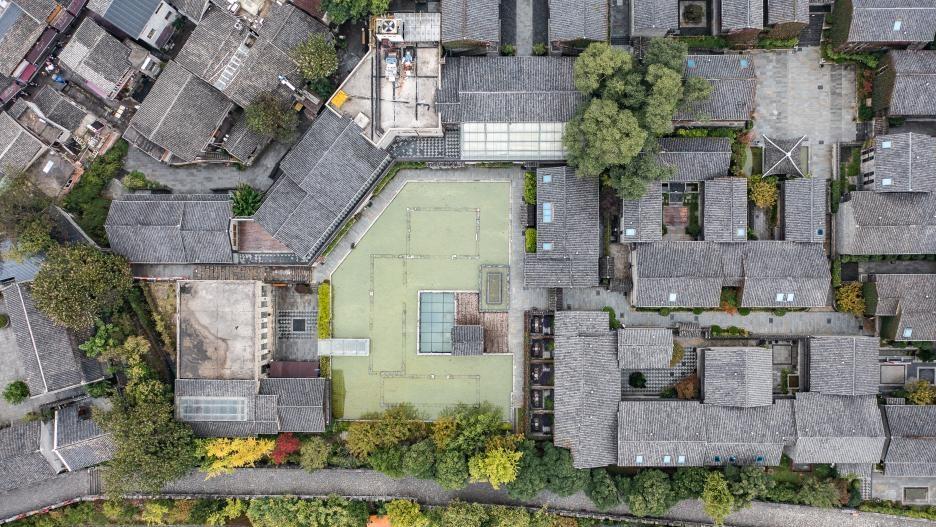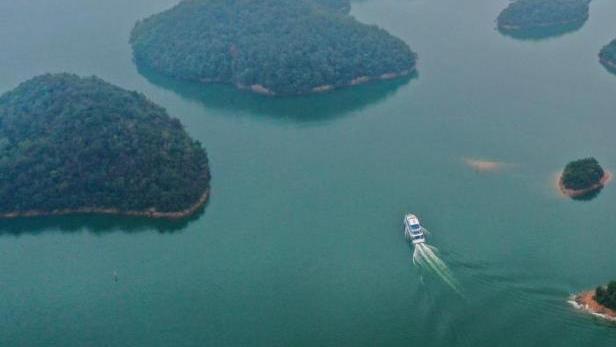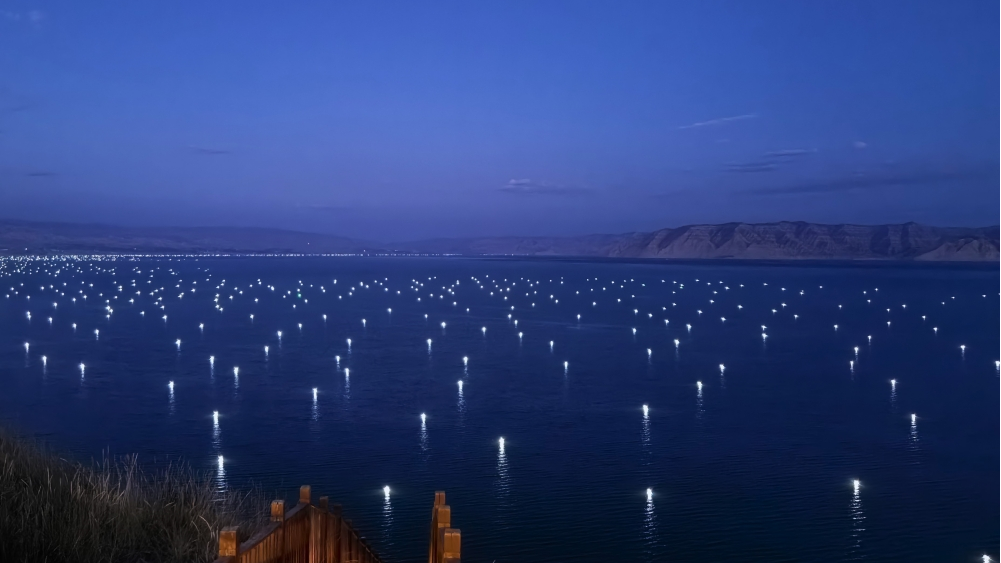Dunhuang Academy achieves remarkable results in spreading fine traditional Chinese culture

Researchers collect digital data of a cave at the Mogao Grottoes in Dunhuang, northwest China's Gansu Province. (Photo courtesy of the Dunhuang Academy)
Dating back to the 4th century, the Mogao Grottoes, a UNESCO World Heritage Site in Dunhuang, northwest China's Gansu Province, features 735 caves carved into a cliff. The grottoes currently house 45,000 square meters of murals and more than 2,400 colorful sculptures.
This year marks the 80th anniversary of the Dunhuang Academy, which administers the Mogao Grottoes and the other five grottoes in Gansu Province. Over the past 80 years, generations of cultural relic workers at the academy have been devoted to protecting and restoring grottoes in Dunhuang, studying Dunhuangology, and spreading the splendid Dunhuang culture.
The academy has become an institution that manages the largest number of world cultural heritage sites in China. It is also the largest institution studying Dunhuangology in the world.

The Mogao Grottoes are home to a priceless collection of Buddhist artwork. (Photo/Chinaculture.org)
Fu Youxu, a mural restorer at the Dunhuang Academy, has been in the profession for 37 years and has restored over 2,000 square meters of ancient murals.
His work demands extreme patience and precision. It often takes more than ten days to restore 1 square meter of fragile yet precious murals. Fu explained that these millennium-old murals are incredibly delicate and may never be repaired once damaged.
Salt crystallization poses a threat to the murals of the Mogao Grottoes, which is why it is often referred to as a "cancer" for murals.
Thanks to seven years of efforts, the Dunhuang Academy's conservation team for cultural relics developed innovative techniques to control salt crystallization and applied the techniques to restore Cave No. 85 of the Mogao Grottoes. In addition, the academy has developed other key techniques for restoring murals and established a complete set of science-based procedures for mural preservation, contributing to the issuance of the Principles for the Conservation of Heritage Sites in China.
In the cave monitoring center of the Dunhuang Academy, a large screen displays real-time monitoring data of the caves and microenvironment of the Mogao Grottoes, including the temperature, humidity and carbon dioxide levels.
"Visitors affect the temperature, humidity and carbon dioxide levels inside the caves. Our job is to keep these variables within an appropriate range. If the data from certain caves exceed the limits, they will be closed temporarily," said Zhang Zhengmo, deputy head of the cave monitoring center, adding that each cave open to the public is equipped with monitoring equipment.

Visitors watch a full-dome digital film at the digital center in Dunhuang, Gansu Province. (Photo provided by Dunhuang Academy)
The application of technologies including the Internet of Things and wireless sensors can alert potential risks and provide credible data support for preventive protection, Zhang said, noting that the academy has established the first provincial-level monitoring and early warning platform for cave temples in China.
Over the past 10 years, the academy has carried out over 130 projects, including grotto preservation, cliff reinforcement, and environmental remediation, fundamentally improving the conservation status of cultural relics in the six grottoes under its jurisdiction.
The academy has established a science-based cultural heritage protection system, which has contributed to over 300 key national cultural relic protection projects in China and offered technical support and solutions for the protection of cultural heritage in countries participating in the Belt and Road Initiative, including those in Central Asia and Southeast Asia.
In addition, the academy has built a rich base of cultural resources by developing a complete system that integrates digital cultural heritage collection, processing, storage, and display technologies. This has significantly promoted the innovative transformation and development of fine traditional Chinese culture, said Su Bomin, director of the Dunhuang Academy.
For example, it offers high-definition panoramic tours of 30 caves on digital platforms; its mini program on the social media platform WeChat has seen a total of over 200 million online interactions.
The academy produced two digital films titled "Thousand-year Mogao" and "Incredible Buddhist Grottoes" respectively, attracting over 14 million viewers over the past 10 years.
The two films are outstanding results of the Digital Dunhuang project, which was put forward in the late 1980s by esteemed Chinese archaeologist Fan Jinshi, then executive deputy director of the Dunhuang Academy, in the hope of permanently preserving this cultural heritage through digital technologies.
It's not easy to move the cultural relics at the Mogao Grottoes to the digital world, said Yu Tianxiu, director of the academy's cultural relics digitalization institute.

Staff from the Dunhuang Academy work on digitizing images taken in a cave at the Mogao Grottoes in Dunhuang, Gansu Province, on September 5, 2023. (Photo/CGTN)
"It calls for well-designed plans for digital collection and science-based verification of these plans according to the sizes, shapes, and preservation of the caves as well as the difficulty of digital scanning. Then we need to use customized tracks and filming vehicles to take photos," Yu said.
Digital collection requires a great deal of patience to avoid any damage to murals. In the end, the academy's team members need to put together images of murals in a cave into one complete piece.
So far, the academy has completed the digital collection of murals in 295 caves and the image processing of 186 caves, and digitalized over 50,000 photographic films, said Su, adding that all the data has been complied into digital files according to specifications. It has also rebuilt seven heritage sites and 45 painted sculptures in the digital world and performed 3D laser scans of 212 caves structures.
At present, over 20 million people have browsed ultra-high definition pictures of the World Heritage Site online and enjoyed a 720-degree panoramic tour of the 30 caves at the Mogao Grottoes on digital platforms.

Tourists visit the Mogao Grottoes in Dunhuang, northwest China's Gansu Province. (People's Daily/Wang Yi)
Su said the academy will continue to strengthen its technological innovation capability and set up a digital record for every cave, mural, and painted sculpture, so as to permanently preserve the information of the murals and painted sculptures at the Mogao Grottoes.
In 1900, a great discovery was made at the Mogao Grottoes. A small chamber, measuring less than 8 square meters and later dubbed the Library Cave, revealed more than 70,000 ancient manuscripts and artworks. The discovery led to the emergence of Dunhuangology in the world. Unfortunately, many Dunhuang manuscripts are scattered overseas due to historical reasons.
The Dunhuang Academy has been leading efforts to formulate a plan to digitalize Dunhuang's cultural relics lost overseas, said Zhao Xiaoxing, director of the academy's Dunhuang Textual Research Institute. The academy has signed cooperation agreements with institutions in the UK, France, Hungary, and other countries to promote the digitalization of Dunhuang's cultural and artistic resources.
In 2022, the Dunhuang Documents Database was launched, providing high-quality academic resources to global scholars in Dunhuangology. The academy will work together with scholars across the world to well tell the stories of Dunhuang and China, Su said.
Photos
Related Stories
Copyright © 2024 People's Daily Online. All Rights Reserved.









